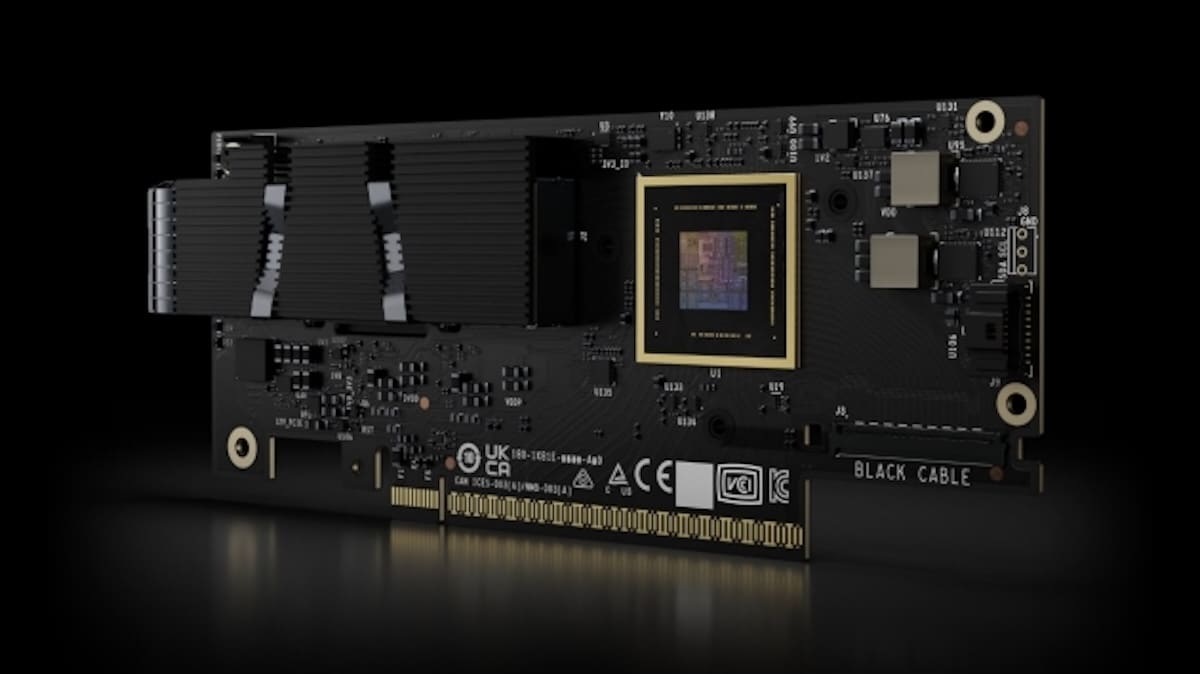During Hot Chips 2025, NVIDIA provided an in-depth presentation of its ConnectX-8 SuperNIC, a next-generation network card capable of reaching speeds of 800 GbE thanks to PCIe Gen6 interface. In an environment dominated by 400 GbE cards, NVIDIA aims to differentiate itself with a product specifically designed for the most demanding AI and HPC environments, where networking becomes a critical bottleneck.
A “SuperNIC” with an integrated switch
The concept of a SuperNIC isn’t new in the industry — Enfabrica used it with their ACF-S — but NVIDIA enhances it with unique features:
- 48 PCIe Gen6 lanes despite showing a standard x16 connector.
- Integrated PCIe Gen6 switch, eliminating the need for additional hardware to split connections.
- Compatibility with both Spectrum-X Ethernet and Quantum-X InfiniBand, offering versatility across different cluster types.
Prepared for accelerated computing
NVIDIA emphasized that networking needs for AI training and inference differ, and the ConnectX-8 is designed to optimize both scenarios. In scaling tests with RDMA, the card reached 800G across various message sizes, although key graphics for 64KB and 128KB messages were omitted — values that Broadcom highlighted in its recent Tomahawk Ultra launch.
The GB300 NVL72 is the first major implementation of this SuperNIC. There, NVIDIA solved a connectivity challenge:
- Grace CPU with a PCIe Gen5 x16 link.
- B300 GPU with a Gen6 x16 link.
- SSD connected via Gen5 x4, leveraging the fact that Grace does not bifurcate to x4 like most server CPUs.
Ecosystem MGX and future support
ConnectX-8 is also integrated into the MGX PCIe Switch Board, where NVIDIA replaces Broadcom chips and enables Gen6 connectivity for future B300 GPUs in PCIe format. Although those cards haven’t been announced yet, the early support confirms NVIDIA is laying the groundwork for the next generation of server accelerators.
More than bandwidth: smart networking
Mellanox’s success before its acquisition by NVIDIA stemmed from its RDMA capabilities, and that philosophy persists in ConnectX-8. The card includes:
- PSA packet processor.
- Data Path Accelerator (DPA) based on RISC-V, acting as an event processor within the NIC itself.
- Congestion control and routing via Spectrum-X Ethernet, optimized for AI workloads.
These functions help reduce tail latency under load and improve training times in large-scale clusters — crucial factors in deploying cutting-edge AI models.
A step ahead of the competition
Currently, ConnectX-8 positions itself ahead of Broadcom’s “Thor” 400 GbE and AMD’s Pollara 400 GbE cards. While availability remains limited — especially for models like the C8240 — NVIDIA’s offering provides data centers with a faster option than current market standards.
The company underscores that by controlling the entire stack (hardware, software, and ecosystem), it can introduce 800G NICs into systems even before server CPUs with native PCIe Gen6 support are widely available.
Conclusion
NVIDIA ConnectX-8 SuperNIC isn’t just a speed upgrade; it’s a key component in the company’s strategy to deliver intelligent networking that keeps pace with the most powerful GPUs and demanding AI workloads.
With 800G bandwidth, advanced RDMA capabilities, and on-board processing, ConnectX-8 marks a significant leap in infrastructure design for AI and HPC, cementing NVIDIA’s position at the forefront of data center connectivity.
Frequently Asked Questions (FAQ)
What is a SuperNIC?
A network card that goes beyond data movement — it integrates compute capabilities, congestion control, and packet processing to optimize performance in AI and HPC clusters.
What speed does ConnectX-8 achieve?
It offers up to 800 GbE connectivity using PCIe Gen6, doubling the speed of currently available 400 GbE NICs.
Which architectures does it support?
Designed to work with both Spectrum-X Ethernet and Quantum-X InfiniBand, enabling scalability across various data center environments.
Why is the integrated PCIe Gen6 switch important?
Because it allows bifurcation of connections and management of multiple links within the card itself, removing the need for external hardware and simplifying design.
via: Nvidia SuperNIC and ServeTheHome

